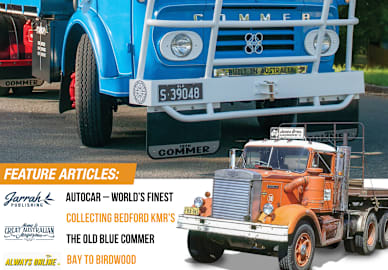Changing Gears
From Bush to the Highway
Out of the blue, Ron was approached by Stewarts and Lloyds to take a load of steel to Mackay, bearing in mind that he only had his timber jinker as a trailer to do this, which he took on as Turners first load of road freight. Unknowingly, Dad had commenced the beginning of what would eventually turn into a thriving road transport business, and Turners Transport was officially born. It would continue to operate under this name until cessation of the business in 2002.
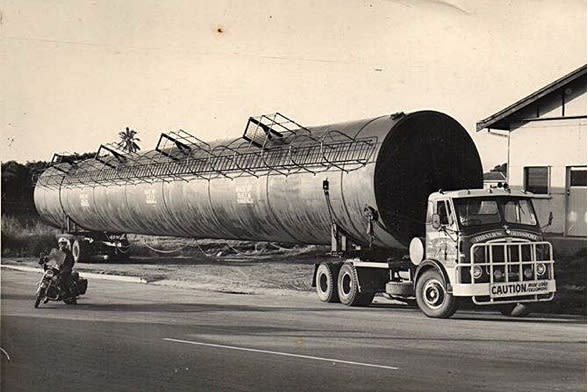
pictured outside the Townsville depot.
Almost immediately, he purchased a bogie 34ft Fruehauf trailer from Paris Timbers in Ingham, and there was no looking back. During this period of transition for the new Turners Transport, Ron was approached by Brambles Engineering in Townsville to shift very large and oversized loads for them throughout North Qld, another challenge to which Ron rose. Some of the loads included large 120ft long chimney stacks for several sugar mills, pre-fabricated items such as buildings, and large tanks. Having executed this task with great success, other manufacturing businesses such as Rheem Australia, Stewarts and Lloyds Manufacturing soon became his clients.
His performance in these jobs also resulted in Brambles contracting Ron to cart all their pre-fab steel from Townsville to Collinsville for the new power station being constructed there; a very big job. Having secured cartage for all southbound steel movements between Townsville and Mackay with Stewarts and Lloyds, William Adams and a few other smaller steel merchants in a very short time, it would only be a few short months before the AEC was not able to cover the workload. So, the tipper was taken off the Dodge and a new single axle Haulmark trailer, one of the first to be purchased in Nth Qld, was paired with the Dodge to cope with the ever increasing workload.
In early 1963, Ron employed Bill Studders as a driver for the AEC. In doing so, he did not realise this would be one of the greatest decisions he would ever make. Bill had been the manager at Hurley and Dewhurst, a scrap metal dealer in Townsville, and his expertise was about to be revealed. Under Bills guidance, the business expanded rapidly. It didn’t take Ron long to see Bill’s potential, and he soon made Bill a manager, even though Bill continued to drive as well.
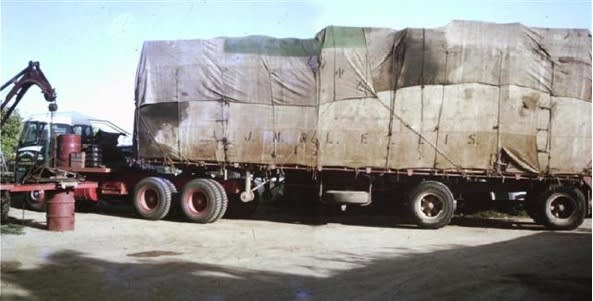
The trailerbelonged to Lindsay Elliswho had a Leyland Beaver and
subcontracted for Hartridge,carting GMH freight to Townsville
In quick time, Bill had secured the cartage of nearly all freight, mainly for all the sugar mills all over North Queensland, out of Walkers Ltd in Mackay and, as a result, trucks and trailers were added to the fl eet on a regular basis. In 1963, a new EJ Holden utility appeared, as did a secondhand 1962 AEC Mandator and a new 36ft Haulmark bogie trailer.
Over the next few short years, another AEC Mandator and AEC Monarch, a Leyland Super Comet, an Albion Reiver 26ft tray body and a Cummins powered Dodge 760 and a single axle 34’ Fruehauf trailer were added to a rapidly growing fleet. Towards the end of 1963, Bill came up with the idea of an express parcel service and, with Ron’s seal of approval, Turners Express Parcel Service was born. Ron had an EJ Holden ute, so it swung into action with two drivers running to Mackay and return every day. Within weeks, an old PMG Kombi van, dressed in company colours was added, to cope with the influx of freight.
Within a few more weeks, an old secondhand International AA148 was purchased and fitted with a flat top body, gates and tarps, and put into service and the Kombi-van was sent to Mackay with Mr. Theo Becker who was to be Ron’s Mackay manager/ delivery driver.
Meanwhile, the general haulage side of the business was expanding at a phenomenal rate, branching out into interstate work by 1965 and, later, subcontracting for Western Transport in the later 1960s.
Back at the overnight service, work was continuing to grow so rapidly that more trucks were needed. So, in early 1964, Ron purchased the first diesel powered Ford D400 sold in Townsville, to cope with the workload, soon to be followed by another two D400s. Sadly, at about this time, Bill left and moved back to Brisbane, but he had left behind some amazing achievements. Just after Bill’s departure, Ron opened his own depot in North Mackay to cater for the overnight freight. It was a very busy time for Turners Transport.

By the late 1960s, the volume of express freight had meant the D400 Fords were way too small and were redirected to more suitable duties having been replaced by an 8 ton FJ series Austin, a newly released tilt cab Leyland and a new Ford D750.
Early in 1965, the Turners entered the house shifting scene, contracting to a gentleman named Joe Barbeler. By 1968, Joe had sold to Phil Turner. Turners transport continued to shift houses until mid to late 1970s, when council building codes regarding removal and replacement of roof sections on the houses made this exercise financially unviable.
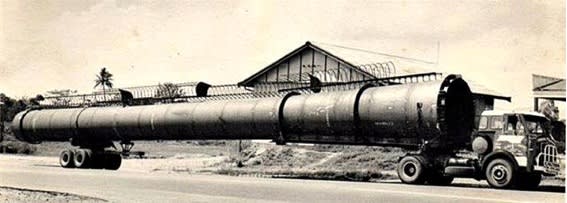
In late 1967, the Monarch was lengthened to take a 21ft tray. By the late 1960s, the fleet and staff numbers were growing at an amazing rate, with no sign of slowing. The steel cartage had
dropped off for various reasons but, in late 1968, Ron secured the cartage contract covering North Qld for Monier Roof tiles, who had just opened a factory in Townsville.
All this, coupled with subcontracting for Western Transport, acquiring a job towing a refrigerated van for Fridgmobile, towing bitumen tankers all over the north for the then Queensland Oil Refineries and, in late 1967, the acquisition of a contract with North Australian Cement Ltd for the cartage of bagged cement bound for Weipa, to the Townsville wharf and local delivery of all bagged cement, which was subcontracted out to John Pratt (who used body trucks for the job), all this added up to a very good customer base and workload. To say the business was doing well was an understatement.
The Queensland Oil Refineries contract alone lasted until the end of 1981. In 1970, a Dodge Fargo and another two Toyota Hi Aces joined the express pick up fleet. 1971 saw the addition of another J1 Bedford for the Charters Towers run, as they were superior in carrying capacity to the Toyota Hi Ace on out-of-town work, and so the Hi Ace was returned to town duties to which they were more suited.
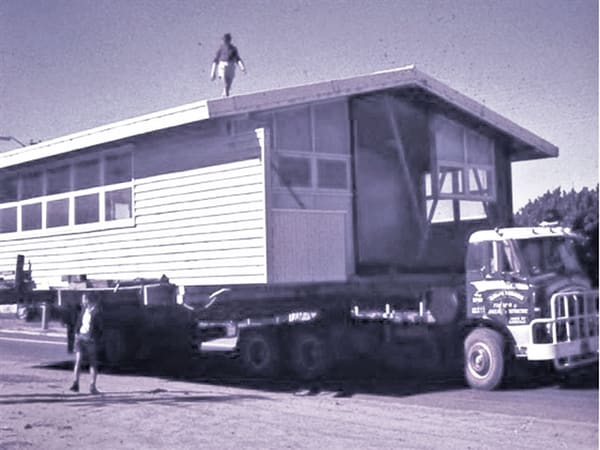
around the corner from where it was originally located
The express side of the business continued to gain momentum and a secondhand Toyota Dyna tray body was added to cope with the workload. Monier roof tiles continued to grow and, within a few months, Ron had secured a contract with Wormald Bros. for all their local carrying, which was handled by a newly acquired secondhand J3 Bedford.
Things were travelling along well, and the only notable event was the loss of the second D400 in an accident 15kms south of Bowen. At the end of this year, both the F model Mack and the bogie drive R600 were transferred from general interstate duties to towing duties for Fridgmobile, with their trailers added to the Monier contract.
1972 began with the NACL cement contract for Weipa terminated, as bulk handling was coming on line for their products. This had no effect on Turner’s operations as the Monier workload was going along nicely, and filled the NACL gap. Early in this period, Comet came on the scene with discussions and forward planning beginning for the first Comet express service run, covering Brisbane to Cairns, an enormous logistical challenge.
Trucks were to be sourced with suitable specs for different areas of the operation, buildings had to be prepared and staffing had to be considered. All in all, this occupied a good deal of Ron’s time but, with the right people in place elsewhere, he had the time to devote to this challenge. Sometime in early 1972, Comet Overnight Transport approached Ron to share their vision of an express service from Brisbane to cover all points of the map in North Queensland; an enormous task in logistics and planning.

This was on the day that US President Kennedy was shot
The plan included establishing a network of depots and agents from Rockhampton northwards to complement the envisaged route, with the criteria for the Rockhampton depot to have driver facilities, as this was to be the changeover point for linehaul drivers.
Negotiations with Gormans Removals in Rockhampton were successful, and the search moved northwards, with Mackay being the next major focus.It is believed that the already established and successful Turners overnight express service between Townsville and Mackay may have been a strong contributing factor in Turners being next on the list in Comets overall plan of approach, as Turner’s established business offered many advantages for both parties. Negotiations between Ron and Comet were successful, and things really began to happen.
Between both companies, they had engaged another local business, Overnight Express N.Q., to fill the remaining part of the puzzle between Townsville and Cairns. This venture also offered both parties the same mutual benefits, as Ron’s appointment had and, in the overall scheme of things, it appeared that the Rockhampton to Cairns route was set in place with great working partners on all sides.
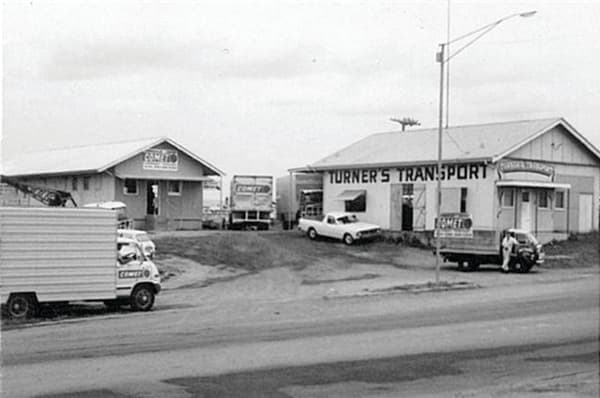
By mid 1972, Ron was scouring brochures on truck specifications to find a suitable linehaul unit for the job in hand, in the 8 ton body truck range. Within a short period, the choice had been narrowed down to two contenders; the V8 Cummins powered Dodge D2F, and the Volvo F86. The only question mark was that Volvo was a relatively unknown quantity in North Qld at that time, but Ron had done his research and, coupled with the fact that the local Datsun dealer was also an agent for Volvo trucks, Ron was quietly confident that Volvo would meet the challenge, and decided that Volvo was the way to go.
Dad took into account, when making his choice, not only performance factors, but also driver comfort which was paramount in his eyes, an area which the Volvo outdid the Dodge, and with amazing ease and reliability.
Immediately, an order was placed for the supply of two F86 trucks to be fitted with 21ft Clark cargo pans, with a third Volvo to follow a short time later. Eventually, all decisions were finalised, and it was ‘countdown to Comet day’.
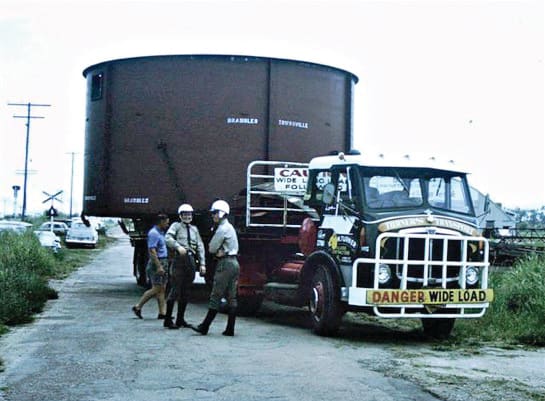
Three Volvo F86 trucks were to handle the linehaul operations. A J1 Bedford was transformed to Comet colours and sent to the Mackay depot, one Townsville Toyota Hi Ace painted red and white, a new Toyota Dyna pantech was added to Townsville in Comet colours, and things were in place, as far as Comet was concerned. All systems were go, and a heavy advertising program was implemented along the length of the proposed route.
Launch day was only two to three days away, taking place with the freight delivery in Townsville on a Monday morning. The amount of north bound freight, accumulating at the Brisbane depot, far exceeded all expectations, and emergency plans were discussed immediately.
What eventually unfolded was a very little known, if not unknown, fact of the northern run, and this is where Ron’s son, Paul entered the overnight express game. As the freight was to be loaded on Friday night for the inaugural run, and with the volume of freight already on hand, a small deviation to the original plan was implemented.
Paul was sent to Brisbane in Ron’s single drive R600 No. 31 with a 35ft fl at top, with gates and tarps to load the freight, and it was decided that since the freight was going to be delivered the following Monday, time was in abundance for a semi trailer to get the job done. As it turned out, even a trailer could not handle all the freight, as after the Cairns, Townsville and Mackay freight was loaded on, it was at maximum capacity, so extra subcontractor body trucks were sourced to handle the overflow.
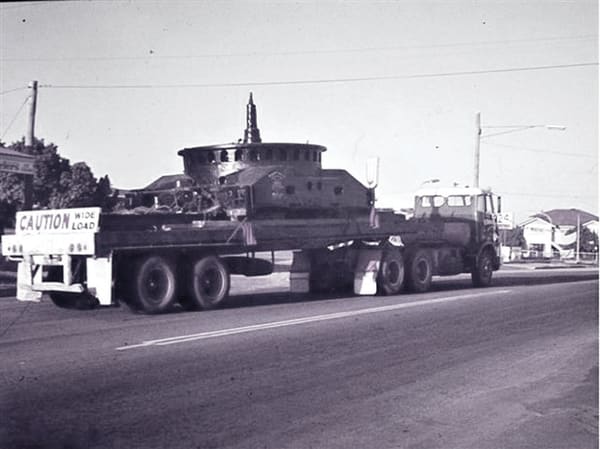
wharf to Mourylian Harbour to dredge the
Harbour allowing ship to load sugar from the new bulk
terminal being built. He hired Brambles to shift the main section
which weighed 50 tons, whilst the main frame section on the AEC was 25 tons
It was a hectic Friday afternoon and evening, with banners being hung on the side of the trailer. Photographers, and anybody who was somebody were in attendance. That night, in June 1972, around 7pm, Paul pulled out of Comets depot in Brisbane with a fully loaded Mack and trailer with the very first North Queensland bound freight.
After dropping the Mackay freight by 9.30am on Saturday, he arrived in Townsville by about 3pm and the appropriate freight distribution for Monday morning delivery schedule was completed. This was the arrival of the well known slogan, “Hello Comet”, and Turner’s had been part of it.
The Volvos actually came online with the second load for the north, not the fi rst, something Paul was proud of. With the initial run accomplished successfully, Volvo F86 fleet No. 35 was ready to go on the Monday night run, with Volvo F86 No. 36 following on the Tuesday night and thus began the linehaul truck rotation.
The third Volvo F86, No. 39, was due to come online within two weeks. The most hectic days of Turner’s express business had begun. Office extensions in the freight shed had already been completed to accommodate extra staff; a 60ft extension of the freight shed was almost ready, and extra pick-up/delivery vehicles, consisting mainly of Toyota Hi Ace, Dyna and Bedfords, were put in place.
Volvo No. 39 was involved in what was the first of many accidents to come. Only months old, it hit a car near the Burpengary weighbridge in August of 1972, sustaining reasonable damage as a result, so it was off to the repair shop and the fleet was down one truck already. This was followed, a short time later, by No. 36 going over on its side in a mud swamp near Gladstone; luckily the soft mud had saved the truck from severe damage. No. 39 was off the road for repairs for about a month, but No. 36 was back in a few days, only needing a new door on the pan, panel work to the LH door and a new mirror.
The latter half of that year saw the F model written off in a sugar cane train accident, north of Tully, and the addition of another 6 ton KGL Bedford for Comet duties. Around this time, plans were afoot for vehicle upgrades which would eventually result in a world first for White Motor Corporation, the first Road Commanders to enter the overnight side of transport, resulting in the birth of White Road Commanders No. 40 and 41, a massive accomplishment as far as White Motor Corporation was concerned; like aeroplanes without wings, GM Detroit Diesel powered with 84mph diffs, left Brisbane at 7pm and arrived in Townsville at 1pm the next day.
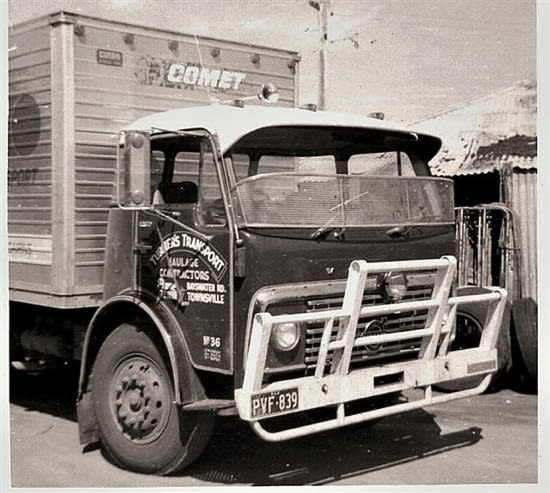
In December, everything was travelling along nicely when No. 39 had another accident. It went through the service bay and building of the Blue Gums service station at Gin Gin. It had hit the building so hard that the truck couldn’t be moved until builders were brought in the next morning to prop up the structure - the damage was substantial.
This service station was a regular coffee stop for the drivers, and subsequent investigations revealed that No. 39 was running fairly late that night, so the unfortunate station attendant had decided to degrease the driveway, as all had seemed quiet. But then, along came No. 39, making a grand entrance by speeding into the driveway. As it was now covered with degreaser, the truck ploughed straight into the service bay.
Freight continued to move at a ridiculous volume at this time and, as a result, extra subcontractors such as Rick Pengelly, Gordon Rixon, and Graham Otto, to name a few, were kept pretty busy.
Comet’s vision was paying off in an unexpected way as all trucks were flat out, and it was about this time that the Turner staff number grew to 34. Often the employees didn’t have a clue as to who was who at the depot. Such was the rapid expansion, and the following story from Paul demonstrates just that.
No. 39 was eventually taken back to Townsville to assess the quite severe damage, which left Comet’s express operation running short of trucks. After a quick repair job with the Porta Power, hammer and dolly, a replacement windscreen and the welding on of a old, slightly damaged bullbar, it was sent back to Brisbane on the Saturday night, hoping all the while that the cab didn’t need to be raised.
“There were a lot of rules in place regarding handling of freight and customer service by both Dad and Comet. All good business practice I might add, but Dad was very severe in policing one: a customer was never to be left unattended at the freight dock. But, one day, I was in the workshop doing a gearbox service on my Mack when Dad wandered out and saw a man standing on the dock. He stuck his head under my Mack and asked, “Who is that?” I replied, with my hands full of gear oil, “I don’t know”, so Dad fi red a rocket up me, went over to the loading dock and enquired, “Are being looked after, sir?” The man replied, “Yeah mate, I work here”. Well, Dad came over to me and asked again, “Who’s that”? My day of glory had arrived! I replied, “Dunno, but I rest my case”. There sure were a lot of people around, including Dad’s own Express Manager, and staff including those delivery drivers shifting Comet freight, as well as Comet management and staff. We almost needed a ‘lollypop lady’ to cross the yard safely”.
All went well, and No. 39 was back in Townsville by the following Wednesday, where it was off to the repair shop for a longer spell, as it needed a whole new front panel fitted to the cab, repairs to the RH door arch, a new RH door and a new bullbar.
Throughout this time, the freight volume continued to grow steadily, and it was becoming very obvious that the 8 tonners were getting too small, so the earlier concept of larger trucks was moved into high gear.

This would signal a very unique and, sadly, short era, which involved the application of the first two White Road Commander body trucks to enter overnight linehaul service in Australia. By now, Ron was seriously looking for a suitable truck and, in typical style, research began on the only two viable manufacturers, Kenworth and White.
It is unknown why Ron chose White trucks, other than the fact he had a V8 Mack FR700 that had been written off due to an accident with a loaded cane train near Tully a few months prior and, possibly the willingness by Duce Commercial Motors in Brisbane to accept the wrecked Mack as a trade on the first White. Another possibility was Ron’s affection for the White name, which went back to his first two trucks, the legendary White Super Power.
After making the deal with Duce’s Nth Queensland sales rep, Mr. Bruce Masters, the first Road Commander fleet No. 40 was no longer a pipe dream, but was due to become a reality in the coming months. Soon after, a deal was sealed for the second Road Commander No. 41, which involved the trading in of Volvo No. 36.
The specifications for the new Whites looked impressive; 8V71N Detroit diesel powered, 10 speed overdrive Eaton Roadranger gearboxes, 34,000lb differentials fitted to White’s own Velvet Ride suspension, which made them capable of a road speed of 84mph, and were fitted with 25ft jumbo style Clark Cargo pantechs on the back. They were also to be fitted with self-weighing scales to assist in maximum but legal loading.
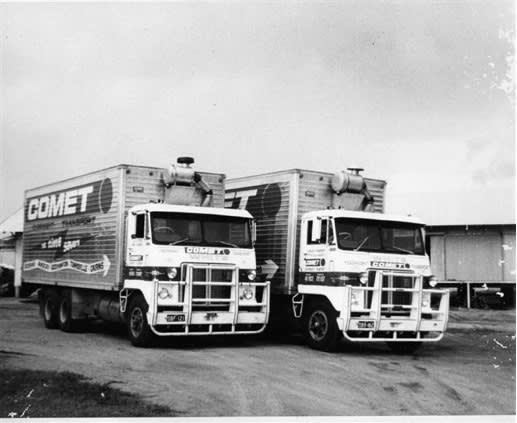
This was also the time when a business and personal friendship between Ron, White Motor Corporation and Duce Commercial Motors was formed, and this would survive for decades to come.
1973 came around, with all areas of Ron’s business, including Comet, experiencing good growth, along with the hustle and bustle that accompanied it. The two Road Commanders were establishing a reputation for themselves on the Comet Express run, and they were often seen on the Bruce Highway. No. 39 was due back from the repairers in mid February, so all was running smoothly, and Monier was still expanding.
When No. 39 was ready it was sent off to Brisbane, but only made it back to Gladstone, where it rolled over on its RHS in a cutting near Gladstone and sustained severe damage, this time to both cab and pan. It was sent back to the repair shop, this time for a major rebuild.
By April, the first new Road Commander No. 46 semi was ordered, due for an August delivery, replacing the wrecked F model on the Fridgmobile job. The bogie R600 was moved over to Monier duties as well as anything else that was required, including bitumen tank work with QAR.
All seemed well and Ron decided to look around for a less expensive replacement for the No. 35 Volvo. He found a secondhand Volvo F86 fitted with Volvo’s retractable lazy axle system and only 18,000 miles on the odometer. The purchase was made and a 24ft Clark Cargo pan was fitted.
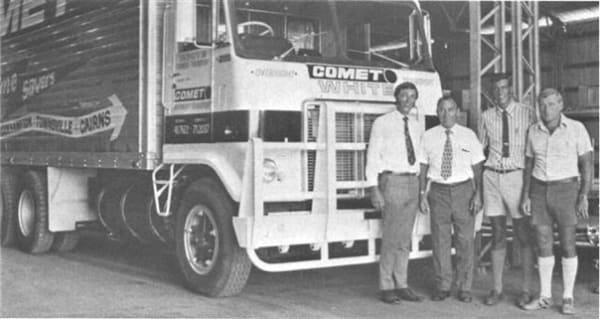
load for the northern run, with Ron second from left
This Volvo was to become No. 45 and entered service in mid 1973; purchased just in time, as White No. 41 rolled over on its side about 40 miles south of the Sarina Range on the old Bruce Highway, due to breaking a walking beam on the LHS rear of the Velvet Ride suspension. No. 45 was quickly sent into the Comet Express fleet. The White was recovered and went back to White Trucks who looked at the cause and determined a few changes should be made. The small but necessary modifi cations were immediately carried out.
White Motor Corporation and Duce Commercial Motors were beginning to emerge as two very customer-focused businesses which impressed Ron greatly. A short time later, No. 41 was back in service and Ron decided to pull No. 35 and No. 39 off the Comet express run as they were getting quite a few miles on them and getting too small for the job. They were redirected into his own express fl eet, leaving Whites No. 40 and 41 and Volvo No. 45 on the Comet run.
Things appeared to get back to normal but the accident toll was starting to play on Ron’s mind. Then, a short time later, about mid 1973, White No. 40 had the right side rear walking beam eye break off the differential housing, which caused the truck to career across the road and nose dive into a deep table drain. The truck rolled end for end, resulting in the only hospitalisation of any of Turner Transport’s linehaul drivers.
Repairs to No. 41 had just been completed at the time of the second rollover, and it was back in action. But, within a month of it returning, Ron decided to ground them both, after giving serious consideration to the suitability of the velvet ride suspension.
Coupled with the driver’s injury, the escalating cost of insurance and the repairs, Ron made the call that the days of Whites No. 40 and 41 as overnighters were over. Only Volvo No. 45 would remain with Comet.

After discussions with White Motor Corporation about the future of No’s 40 and 41, White offered to rebuild both trucks to whatever configuration Ron desired. After sizing up the situation, Ron suggested that “a couple of prime movers wouldn’t go astray at the moment”, as opportunities to be a tow operator with Fridgmobile were looking very attractive.
At the time, he already had No. 46 working for them, so White suggested they could turn both the trucks into prime movers if he desired. Dad was sold on that idea, but the only problem was he needed at least one truck straight away.
White responded by saying they could have No. 41 back to him as a temporary slimline prime mover within a few months but, to fill the immediate gap, they could offer Dad the use of one of their ‘loan’ trucks, and use it till they got No. 40 and 41 back on the road as finished sleeper cab prime movers. The loan truck was a White 7564 cab over engine model and was the forerunner to the Road Commander. This truck was supplied free of charge to fill the void until 40 and 41 were converted; all Ron had to do was supply the fuel, driver and tyres when required.
By late 1973, it was plainly obvious that the unexpected growth of Comet would soon outgrow Ron’s depot space, and negotiations were already under way for Comet to relocate to their own much larger premises with more of their own vehicles coming online. With this in mind, Ron was keen for more prime movers for his own business, and the decision was easy to convert Nos. 40 and 41 into prime movers.
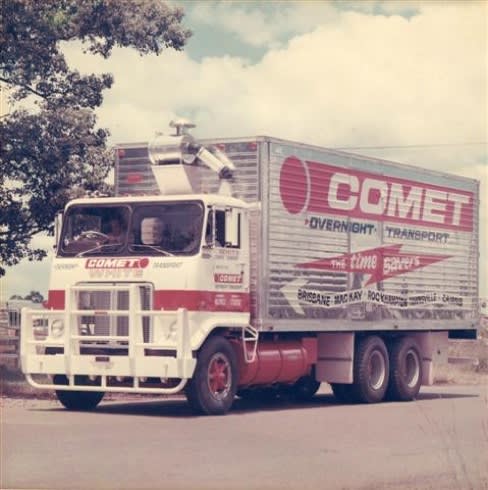
Volvos No. 35 and 39 were swung across to Ron’s own express service, with the Ford D750 and Leyland Tilt cab being sold off. By years end, No. 41 was back as a prime mover, although still sporting the slim line cab which was to be replaced as soon as No. 40 was rebuilt and back on the road.
The end of an exciting era in Ron’s business was beginning to unfold, with only Volvo No. 45 still running with Comet, and the strain of the previous few years was beginning to show on Ron’s face - he was no longer a spring chicken, at 50 years of age.
All of this heralded the end of what had been a successful partnership between a freight giant and a small businessman and, by very late 1973, a mutual agreement was reached to part ways, particularly as Comet had grown so big, and it seemed the best thing for all concerned. No. 45 would still work for Comet.
The Volvo would later be involved in a head on accident with a Jewell’s Furniture Removals truck on a narrow wooden bridge near Mt Ossa, north of Mackay, in early 1974. At this point, Ron decided to withdraw altogether from express linehaul work and so, in the early months of 1974, IPEC approached Ron with a very good offer for his own overnight business, which he accepted.
He kept D400 No.12 and Volvos Nos. 35 and 39 and Toyota Hi Ace No. 42, with the rest of the express fleet going with the sale. I think Ron was relieved to see a lot of the responsibility that was involved in such a huge operation disappear with these events.
This would see the final end of his association with Comet, but the long term friendships created over the period still persisted for a long time.
*Paul Turner and Darren Hingston









